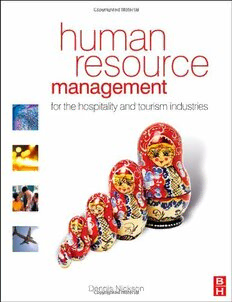
Human Resource Management for the Hospitality and Tourism Industries PDF
320 Pages·2007·2.281 MB·English
Most books are stored in the elastic cloud where traffic is expensive. For this reason, we have a limit on daily download.
Preview Human Resource Management for the Hospitality and Tourism Industries
Description:
Human Resource Management for the Hospitality and Tourism Industries takes an integrated look at HRM policies and practices in the tourism and hospitality industries. Utilising existing human resource management (HRM) theory and practice, it contextualises it to the tourism and hospitality industries by looking at the specific employment practices of these industries, such as how to manage tour reps or working in the airline industry.It initially sets the scene with a broad review of the evidence of HRM practice within the tourism and hospitality industries. Having identified the broader picture, the text then begin to focus much more explicitly on a variety of HR policies and practices such as:.Recruitment and selection: the effects of ICT, skills required specific for the industry and the nature of advertising.Legislation and equal opportunities: illegal discrimination and managing diversity .Staff health and welfare: violence in the workplace, working time directives, smoking and alcohol and drug misuse.Remuneration strategies in the industry: the 'cafeteria award' approach, minimum wage and tippingHuman Resource Management for the Hospitality and Tourism Industries will be illustrated throughout with both examples of best practice for prescriptive teaching and discussion, and international case studies to exercise problem solving techniques and contextualise learning. It incorporates a user friendly layout and includes pedagogic features such as: chapter outlines and objectives, HRM in practice - boxed examples, reflective review questions, web links' discussion questions and further reading.Accompanying the text are online supplementary lecturer materials including downloadable figures from the book, PowerPoint slides, further cases and extra exercises and points for discussion. * An integrated look at HRM policies and practices in the tourism and hospitality industries * A comprehensive contextualisation of the nature of the industries, the dynamics of service quality and the variety of HR policies and practices, including a realistic treatment of training, labour markets, employee relations and remuneration* International examples showcase good practice in a variety of organisations, such as Pr??t a Manger, Marriott and South West Airlines, as well as a number of examples of good practice in SMEs
See more
The list of books you might like
Most books are stored in the elastic cloud where traffic is expensive. For this reason, we have a limit on daily download.
